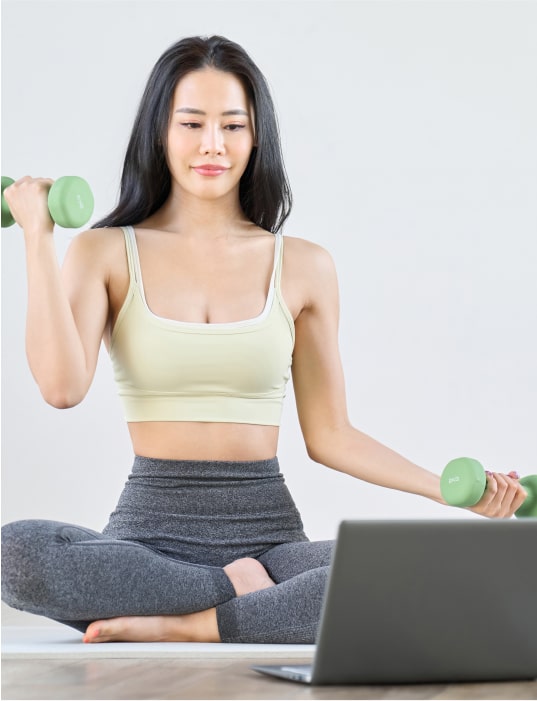Are You Earning Up to Your Potential?
Most personal trainers are undervaluing their time and skills. Our Personal trainer Revenue Calculator helps you find out what you should be making, and how to get there.
No guesswork. Just real numbers.
.jpg)
Useful Tips by Trainers to Improve Posture
It may have been due to years of slouchy sitting (while reading or writing or doing any other chore) that you have ended up with a screwed-up posture. Still, experts suggest that only a small time frame is enough to set things straight again. Chalk out a 10-minute daily routine dedicated to posture workouts; you are good to go. You can work wonders to improve your posture with all the proper practices.
Before getting to the posture improvement tips, let's learn about the basics. By definition, posture means how your body holds itself. According to health experts, a well-balanced and strong body promotes efficiency, movement, endurance, and overall health and well-being. It means that, besides merely helping you sit and stand straight and properly, good posture enables you to carry out daily movements easily.
The effects of bad posture are usually noticed in the upper body; however, if you want to improve it, you need to work all over. You will have to work on strengthening the muscles towards the back of your body, also known as the posterior chain, neck, glutes, and core. The reason behind this is that you need strong muscles in the back to help keep you in a straight or upright position. This will help hold your shoulder blades firm, back, and down. Strong abdominal and leg muscles will aid in properly aligning the pelvis and spine.
The good news is that there are numerous ways to work on all the above-outlined critical areas. Keep scrolling for some tried and tested tips to enhance your posture.
What Is "Good Posture," Exactly?
Good posture is referred to as a neutral spine. A person with good posture has balanced muscles around the spine, giving equal support to the body. While sitting, your feet should be flat on the floor, and your hips should evenly balance your body weight. The back should be straight apart from some natural curves already present in your thoracic, lumbar, and cervical areas. The shoulders must fall back relaxed, while your ears must be lined above the collar bones.
Your standing posture should be slightly bent at the knees so that you are not hyperextending or locking the joints. Now that we know about good posture let us learn how to correct posture.

Proper posture guides.
Proper posture is more than just sitting and standing straight to look your best. It is essential for your long-term health. Ensuring that you can hold your body correctly while sitting, standing, or walking, will help you prevent injuries, pain, and other health issues.
How to fix posture?
You can maintain proper posture in the following mentioned ways:
- Be aware of your posture while doing regular activities such as sitting, eating, washing dishes, watching television, etc.
- Maintain a healthy weight as extra weight tends to weak abdominal muscles resulting in lower back pain, pelvic, and spinal issues.
- Stay active and practice exercises that target posture improvement; tai chi, yoga, and other classes are excellent activities that help strengthen the core.
- Wear comfortable shoes and avoid high heels that throw your body off balance and stress the back and leg muscles while harming your posture.
- Ensure that your work surfaces are at a proper and comfortable height; this includes cooking surfaces, eating surfaces, and your office desk.
The Best Way to Correct Posture While Sitting
Most people spend a lot of their time sitting, whether it is at home, at the office, or at school. Maintaining a proper posture while sitting and taking breaks from continuous sitting is essential. Here are a few tips to correct posture while sitting!
- Switch your sitting position at regular intervals
- Relieve muscle tension by stretching yourself from time to time
- Get up and take short walks.
- Relax and stretch your shoulders; don't sit in a slumpy position.
- Keep your elbows close to your body.
- Keep your back supported by sitting in a chair with a proper backrest; otherwise, keep a pillow behind you.
- Ensure that your feet touch the floor, or else use a footrest.
- Ensure that your hips and thighs are fully supported; opt for a nicely padded seat, with your hips and thighs placed in a parallel position to the floor.
1. Bridges

Want to know how to easily improve posture? The bridge pose is one excellent posture exercise for opening the chest while working the core, quads, lower back, transverse abdominals, and glutes. Here's how you do it!
- Lie straight on your back and bend your knees, placing your feet flat on the ground
- Place your hands straight by your side with both palms facing the ground
- Lift your hips and tuck your chin, not letting it touch the chest
- Clasp your hands behind your back
- Squeeze the glutes, and do not spread your knees wider than your hips
- Hold the position for five deep breaths
- Release your hands and slowly lower your body
2. Plank

If you are still worried about how to correct posture, then start practicing plank exercises. Plank is a foundational pose that helps you to hold yourself together - just like a firm wooden plank. It dramatically benefits abdominal strength, strengthening your arms and wrists while improving your neck and upper back posture with time. Here's how you do it!
- Begin in the position of a plank; face down with toes and forearms facing the food
- Work your abdominal muscles while you pull your navel towards your spine.
- The torso should be rigid and straight, and your body must be in a straight line without bending anywhere
- Your shoulders must be down and not crumbled towards your ears
- Your heels must be over the balls of your feet
- Hold the position for at least 10 seconds
- Release the position
- Repeat
💪 Got an idea for a brand? Let's bring it to life.
Launch your own fitness app with FitBudd in minutes!

💪 Got your brand name? Let’s bring it to life.
Launch your own fitness app with FitBudd in minutes!


88% trainers worldwide gave us 5 stars
Transform your fitness business with the power of your branded app on iOS and Android.
Try for FREE3. Hip flexor stretch

If you are experiencing tight hips, then it can further lead to inhibited gluteal muscles, lumbar hyperextension, and anterior pelvic tilt. Stretching the hip flexors can greatly help you maintain a good posture. Here's how you can do hip flexor stretches!
The couch stretch:
- Kneel in front of a couch and put one foot in front of you, placing it on the floor.
- Press the other leg against the couch in a horizontal position.
- Give a slight push to your hips while squeezing the hamstring and glutes.
- Hold the stretch for half a minute, then change your legs and repeat.
4. Mountain Pose

The mountain pose looks simple but needs certain nuances to make the most of it, especially for improving posture. This pose helps to identify when your body is in perfect alignment. It is one of the best-improved posture exercises. Here's how you do it!
- Find a neutral position to stand where you are neither leaning backward nor forwards
- Your big toes should touch each other while standing, and your heels must be separate
- Contract the front thigh muscles while raising the kneecaps
- Keep the spine straight with just its natural curves
- Your shoulder blades should be right above your pelvic bones
- Hang your arms by your side, bending them slightly at the elbows with palms facing forward
- The neck should be straight
- Remain in this position for ten deep breaths
5. Standing quad stretch

Stretching your quadricep muscles enhances flexibility and posture. This stretch is best for good posture exercise. This is a common warmup exercise that most athletes practice. Here is how you can do a simple standing quad stretch!
- Stand on one leg, hold on to something like a chair or wall if you need balance
- Bend one knee and pull the heel towards the buttock
- Hold your heel with the opposite hand
- Feel the pull in your hip and thigh
- Relax your shoulders and breathe deeply for 30 seconds
- Release and repeat with the other leg
6. Child’s Pose

The child's pose is a great way to work on your posture and is quite popular with huge benefits. It is best suited for individuals unable to do difficult poses. Here is how you can nail the child's pose!
- Sit in a kneeling position with your toes touching each other while you sit with your knees aligned with your hips
- Exhale and bend forward with your chest touching your thighs and place your forehead on the floor
- Your arms should rest beside your body with palms facing upwards
- Keep taking deep breaths while you remain in this position for a minute or two
- Get up slowly and repeat.
7. Proper posture while standing

The reliance on technology today has taken a toll on our posture. Most individuals nowadays stand with a hump at the back that is difficult to eliminate. It is imperative to maintain a proper posture while standing, or else your body shape will suffer and lead to back pain and other issues in the long term. Here is how you can maintain a proper posture while standing.
- Stand tall and straight with your neck straight
- The shoulders should fall back and not slouch forward
- Pull in your stomach
- Place most of your body weight on the balls of your feet
- Keep your chin straight, and head leveled
- Let the arms fall naturally at either side of your body
- Your feet should be in alignment with your shoulders
8. Maintaining Good Posture While Sleeping
Good posture is synonymous with sitting or standing and helps you sleep properly. Your back ligaments and muscles must relax while sleeping; otherwise, you will suffer from bad posture problems.
Select the right mattress for sleeping, which gives good back support and is comfortable. Your pillow should be correct and support your head and neck properly. Never sleep on a high pillow that can cause a terrible strain on your back, neck, and shoulders. Opt for a cushion with a convenient height that allows you to sleep comfortably in every position. It is suggested to change your pillow every year.
Talking of sleeping in a proper posture, keep the following points in mind!
- No matter which position you sleep in, always keep your hips, shoulders, and ears aligned.
- Never sleep on your stomach as it throws the spine out of position.
- Keep a small pillow under your knees when you sleep on your back, as it reduces the pressure on your spine while sleeping.
- While sleeping on your side, put a small pillow between your knees to reduce stress on the lower back and hips.
9. Use a wall to teach yourself the correct posture
You can use a wall to do a few exercises, which will significantly help improve your posture. Here's how you can do it!
- Stand with your head, shoulders, back, and butt against the wall. Your feet should be about 6 to 9 inches away from the wall.
- Start with a neutral spine. Draw your naval towards your spine and feel your mid back touch the wall.
- Slightly tuck your chin while touching the wall with the back of your head.
- Position your arms up straight and place them on the wall above. The back of your hands should touch the wall in a "V" position.
- Now bend your elbows while sliding your hands down the wall. You should stop sliding when your hands reach just above your shoulder. All along, your head, buttocks, and truck should press against the wall.
- Repeat 5 to 10 times
10. Find your center by standing up straight and tall

Most people tend to stiffen up and over-extend while trying to stand upright. Remember that while standing straight, your spine should never feel stretched. It should be in its natural position and feel comfortable. You can find your center by standing up straight and tall.
- Arch your back fully, slouch forward, arch again, and release for a neutral, upright position
- Lengthen your spine comfortably
- Roll back your shoulders and drop them down
- Place your feet firmly on the ground
- Take a deep breath and relax
- Pull in your abdomen
- Do not lock your knees
11. Practice yoga to increase flexibility and help with posture

Yoga is a great practice to improve your flexibility and posture. Yoga experts believe that consistent yoga practice can have significant health benefits. The stretches done in yoga can release tight muscles of the body, especially those of the back, shoulders, and legs. Yoga further aids in improving postural problems by enhancing your core strength. You can practice yoga at any time of the day, do not eat at least 2 hours before doing your yoga poses.
Yoga helps enhance the elasticity of the connective tissues, like the ligaments, tendons, and muscle fascia. These bind the different parts of the body together. Regular yoga helps loosen and lubricate these tissues, allowing them to move more freely, which helps to improve a person's posture and flexibility.
Some of the best yoga poses for better flexibility and posture are as follows:
- Mountain pose
- Cat-cow stretch
- Bridge pose
- Eagle pose
- Plank pose
- Child’s pose
- Standing forward bend
- Bow pose
- Low lunge
- Camel pose

Conclusion
Bad posture causes undue strain on muscles and joints, further increasing aches and making you feel tired now and then. On the contrary, good posture is linked to increased energy, fewer aches, and improved spine and joint health while exuding confidence. Well, having a good posture is more than just being able to look good and feel confident. If you work to improve your posture, you will slowly become more aware of your joints and muscles than before, which will make it easier for you to rectify your posture.
Good posture is all about holding your body correctly and maintaining the natural curves of your body. Bid farewell to all the slouching and slumping. It's time to work on the correct moves and practice the right exercises and poses to correct all the damage caused by bad posture. Follow our guide, and you are sure to win this race.
These are the best exercises for better posture. If all these tips feel too much to you, you can start slowly by practicing 2 to 3 moves initially, then increasing gradually. Remember, consistency is the key to improvement. You should be aware of proper posture in the long run and always take care to sit, stand, and move correctly to avoid damages caused by bad posture.
Frequently Asked Questions

Creative Fitness Challenges Ebook
Discover exciting challenges to boost your workouts and keep your fitness journey thrilling.
Download Now
Templates
These functional templates have the power to make any fitness trainer's life easier.
Subscribe To
Our Blog
















-1-min.jpg)











